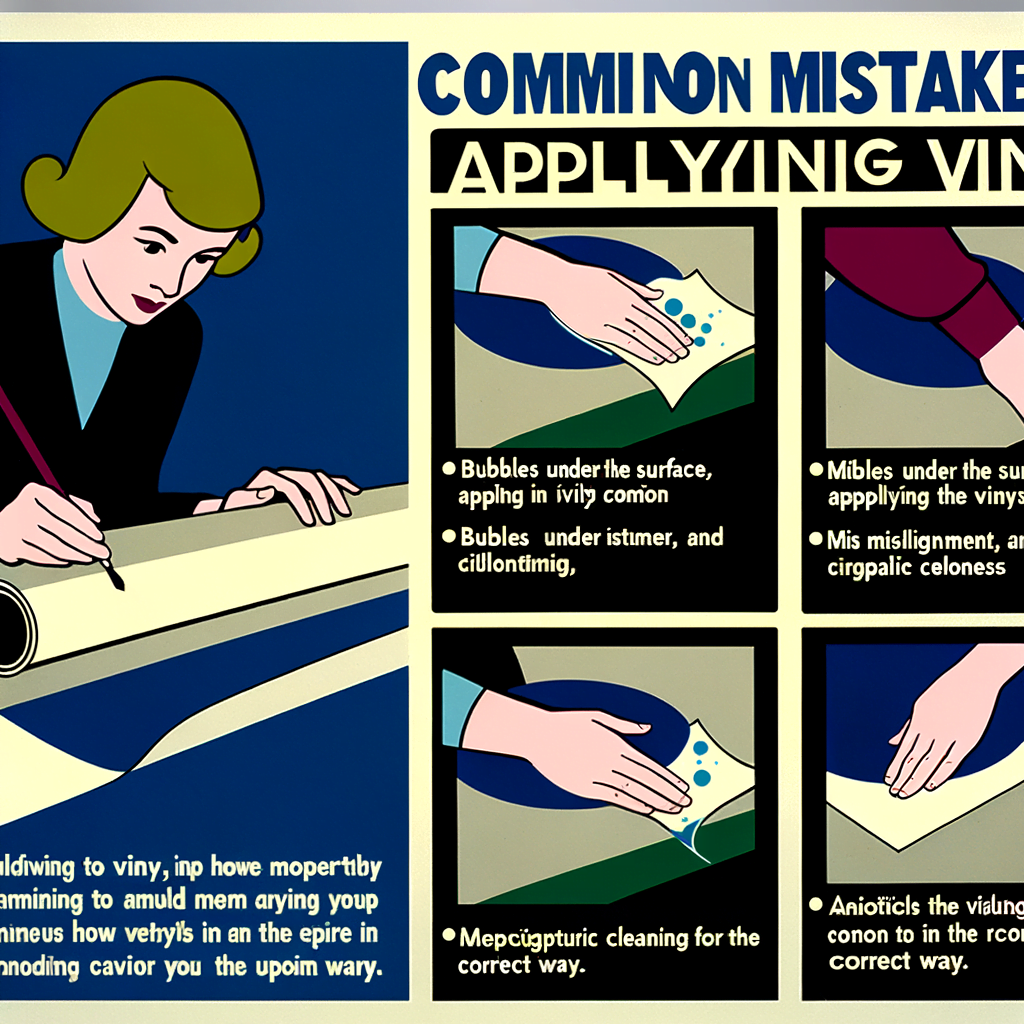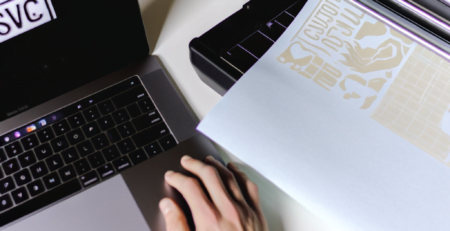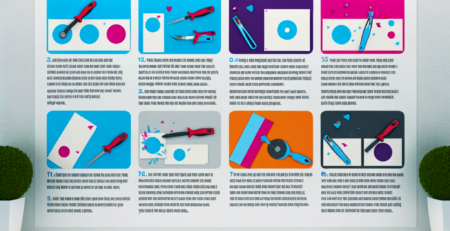Errori comuni nell'applicazione del vinile e come evitarli
Sommario
“Perfect Your Vinyl Projects: Sidestep Common Mistakes with Expert Tips!”
introduzione
Common vinyl application mistakes can lead to unsatisfactory results, wasted materials, and additional costs. Vinyl graphics and decals are popular for their versatility and durability, but improper application can quickly diminish their appearance and longevity. Understanding the potential pitfalls in the vinyl application process is crucial for professionals and DIY enthusiasts alike to ensure a smooth, bubble-free finish. This introduction will highlight some of the most frequent errors encountered during vinyl application and provide insights on how to avoid them, ensuring a professional-looking result every time. Whether it’s inadequate surface preparation, incorrect vinyl handling, or environmental factors, being aware of these common mistakes can help you achieve a flawless application.
Top 10 Vinyl Application Errors and Tips for Perfect Installation
Errori comuni nell'applicazione del vinile e come evitarli
Vinyl application is a popular method for creating signage, decorating walls, and customizing vehicles, among other uses. However, the process can be fraught with potential errors that can lead to less-than-desirable results. Understanding these common mistakes and learning how to avoid them is essential for achieving a perfect installation.
One of the most frequent errors in vinyl application is not preparing the surface properly. Vinyl adheres best to clean, dry, and smooth surfaces. Any dirt, grease, or residue can prevent the vinyl from sticking correctly, leading to bubbles or peeling. To avoid this, thoroughly clean the surface with a suitable cleaner and allow it to dry completely before applying the vinyl.
Another mistake is not using the right tools. A squeegee is essential for applying vinyl to ensure that it lays flat and to remove any air bubbles. Using your hands or an improper tool can result in an uneven application and visible imperfections. Invest in a good quality squeegee and use firm, consistent pressure for the best results.
Improper alignment is also a common issue. When vinyl is applied crooked or off-center, it can ruin the aesthetics of the design. To prevent this, use reference points or guidelines to position the vinyl correctly before it touches the surface. This can be done by measuring the area and using masking tape to create a grid or outline.
Many individuals make the mistake of removing the backing paper too quickly. This can cause the vinyl to stretch or tear, especially if it’s a large or complex design. Instead, peel the backing paper away slowly and steadily, ensuring the vinyl is securely adhered to the transfer tape and the surface.
Temperature and environmental conditions play a significant role in vinyl application. Applying vinyl in extreme temperatures or high humidity can affect its ability to stick and cure properly. Always apply vinyl in a controlled environment, ideally at room temperature, to ensure optimal adhesion and longevity.
Rushing through the application process is another error that can lead to mistakes. Vinyl application requires patience and attention to detail. Take your time to smooth out the vinyl, work out any bubbles, and ensure the edges are firmly sealed. Rushing can lead to overlooked imperfections that are difficult to correct later.
Overlooking the type of vinyl for the specific application can also lead to problems. There are different types of vinyl for various purposes, such as permanent, removable, or heat transfer vinyl. Using the wrong type can result in vinyl that doesn’t stick properly or damages the surface upon removal. Always choose the appropriate vinyl for your project and intended surface.
Failing to use transfer tape where necessary is a mistake that can cause the vinyl to lose its shape or alignment. Transfer tape helps to move the vinyl from its backing to the surface without distortion. For intricate designs or lettering, transfer tape is indispensable for maintaining the integrity of the design.
Lastly, neglecting post-application procedures can compromise the durability of the vinyl. After applying the vinyl, it’s important to go over it with a squeegee once more to ensure a firm bond. Additionally, allowing the vinyl to cure for the recommended time before exposing it to elements or use will help solidify the adhesion.
In conclusion, vinyl application can be a smooth process when approached with care and knowledge. By avoiding these common mistakes and following the tips provided, you can ensure a flawless finish that stands the test of time. Remember, preparation, patience, and precision are key to perfect vinyl installation.
Avoiding Air Bubbles and Wrinkles: A Guide to Flawless Vinyl Application

Errori comuni nell'applicazione del vinile e come evitarli
Vinyl application is a skill that requires patience, precision, and a keen eye for detail. Whether you’re a professional working on a large-scale project or a DIY enthusiast tackling a home decor task, the goal is to achieve a flawless finish. However, even the most experienced individuals can encounter issues such as air bubbles and wrinkles, which can mar the appearance of the final product. Understanding the common pitfalls and learning how to avoid them is essential for a successful vinyl application.
One of the most frequent mistakes made during vinyl application is not preparing the surface properly. A clean, smooth, and dry surface is critical for vinyl adhesion. Any dust, grease, or residue can prevent the vinyl from sticking correctly, leading to air bubbles and eventual peeling. To avoid this, thoroughly clean the surface with a suitable cleaner and allow it to dry completely before applying the vinyl. Additionally, using a lint-free cloth can help eliminate any remaining particles that might cause imperfections.
Another common error is rushing the application process. Vinyl needs to be applied slowly and carefully. Hastily laying down the material increases the likelihood of trapping air bubbles beneath it. To prevent this, use a squeegee or a similar tool to smooth out the vinyl from the center towards the edges. This technique helps to push out any trapped air and ensures a tight bond to the surface. It’s also beneficial to work in small sections, particularly with larger vinyl pieces, as this gives you more control and reduces the risk of wrinkles.
Temperature and environmental conditions play a significant role in the success of vinyl application. Vinyl can become brittle in cold temperatures and overly pliable in heat, making it difficult to handle. Therefore, it’s important to apply vinyl in a controlled environment, ideally at room temperature. If you must work in less-than-ideal conditions, using a heat gun or hairdryer can gently warm the vinyl, making it more flexible and easier to work with. However, be cautious not to overheat the material, as this can cause it to stretch or distort.
Using the wrong type of vinyl for the job can also lead to application issues. There are various types of vinyl, each designed for specific surfaces and uses. For instance, using a calendared vinyl meant for flat surfaces on a curved or textured surface can result in wrinkles and poor adhesion. Always select the appropriate vinyl for your project, considering factors such as surface type, indoor or outdoor use, and durability requirements.
Lastly, many individuals fail to remove the transfer tape correctly. Transfer tape is used to move the vinyl from its backing to the desired surface. Removing it too quickly or at the wrong angle can create tension, leading to wrinkles or even tearing the vinyl. To avoid this, peel the transfer tape back slowly at a 180-degree angle, ensuring that the vinyl stays in place. If any sections lift, gently press them back down and continue the process until the transfer tape is completely removed.
In conclusion, achieving a flawless vinyl application is within reach if you take the necessary precautions to avoid common mistakes. Proper surface preparation, patience during application, attention to environmental conditions, choosing the right vinyl, and careful removal of transfer tape are all crucial steps. By following these guidelines, you can ensure a smooth, bubble-free finish that looks professional and lasts.
The Do’s and Don’ts of Vinyl Application: Common Pitfalls to Steer Clear Of
Title: Common Vinyl Application Mistakes and How to Avoid Them
Vinyl application is a popular technique for creating signs, decorating walls, and customizing various items. However, the process can be fraught with potential errors that can lead to unsatisfactory results. Understanding the common pitfalls in vinyl application is crucial for achieving a professional and lasting finish.
One of the most frequent mistakes is neglecting to properly prepare the surface. The adhesion of vinyl is significantly affected by the cleanliness and texture of the surface to which it is applied. Dust, grease, and other residues can prevent the vinyl from sticking effectively, leading to peeling and bubbling. To avoid this, it is essential to thoroughly clean the surface with a suitable cleaner and allow it to dry completely before applying the vinyl. Additionally, for surfaces with texture, using a primer can create a smoother base that enhances vinyl adhesion.
Another common error is failing to use the right type of vinyl for the job. There are various types of vinyl, each designed for specific applications and surfaces. For instance, using calendared vinyl for a curved surface instead of cast vinyl can result in the material not conforming properly and eventually lifting. It is imperative to select the appropriate vinyl type based on the project requirements, such as indoor versus outdoor use, flat or curved surfaces, and the expected duration of the application.
Moreover, many individuals overlook the importance of temperature during application. Vinyl has an optimal temperature range for application, and applying it in conditions that are too cold or too hot can affect its pliability and adhesive qualities. Cold temperatures can make the vinyl brittle and less sticky, while hot temperatures can make it overly soft and difficult to handle. To circumvent this issue, always apply vinyl in a controlled environment or within the recommended temperature range provided by the manufacturer.
Improper handling of the vinyl is yet another mistake that can lead to unsightly air bubbles and wrinkles. When applying vinyl, it is crucial to use a squeegee or a similar tool to smooth out the material from the center outward, ensuring that air is pushed out and the vinyl lays flat. Rushing this process or using excessive force can create imperfections that are difficult to correct. Patience and gentle, consistent pressure will yield the best results.
Lastly, cutting corners on post-application procedures can compromise the longevity of the vinyl. After application, it is advisable to go over the edges and seams with a heat gun and a seam roller to ensure a secure bond. Skipping this step can leave edges vulnerable to lifting and peeling, especially in high-traffic areas or on surfaces that are frequently handled.
In conclusion, while vinyl application may seem straightforward, it requires attention to detail and an understanding of the material’s properties. By preparing the surface properly, choosing the right type of vinyl, applying it in the correct temperature conditions, handling it carefully, and following through with post-application techniques, one can avoid the common pitfalls associated with vinyl application. Adhering to these do’s and don’ts will not only enhance the appearance of the final product but also ensure its durability and longevity.
Conclusione
Conclusione:
Common vinyl application mistakes include improper surface preparation, misalignment, air bubbles, incorrect temperature, and using the wrong type of vinyl. To avoid these errors, ensure the surface is clean, dry, and smooth before application. Use alignment techniques such as grids or laser guides, and apply the vinyl slowly to prevent air bubbles. Be mindful of the temperature, as extreme conditions can affect adhesion. Lastly, choose the appropriate vinyl for the surface and intended use. By following these guidelines, one can achieve a professional and durable vinyl application.





Lascia un commento